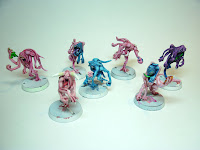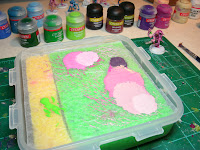Back in August I did a piece on how to make your own wet palette. In that post I focused on the principles of using a wet palette and some of it simple concepts. Switching from dry painting to wet blending is a huge step forward for anyone's hobby, but it also comes with its own list of complications as well as benefits.
In this post I'll take you through a step-by-step of how to take a model (in this case a pink horror) from prime coat to the table. I'll also address some of the bumps-in-the-road you may encounter from using this technique and little tips to help you paint smarter.
To get started let's go over our checklist: painting mat (in my case an exacto cutting board), wet palette, mixing brush (to blend paints on palette, I use an old standard dry brush), basing brush, fine detail brush, paints, water, towel/napkin, good lighting source (I prefer a fluorescent desk lamp for a bright, clean, white light), and a cup of your favorite caffeinated beverage (mine's green tea with lemon).
Begin by cleaning your model of extra flash or mold lines (I miss them sometimes in my excitement to get painting) and apply a primer coat. For many projects that are flesh or lighter colors I choose white primer to keep the colors bright. When it comes to large scale models with lots of recesses, shadowing or armor plating I prefer black. In this case we'll use white for the pink horror.
This particular pink horror is going to have two primary base colors, magenta and pink. Using a wet palette will allow us to seamlessly blend the two colors together to give the effect that the horror is shifting color. If you are uncomfortable painting two side-by-side bases apply the following steps, but with only one base.
To achieve the magenta base we make a 1:1 blend of Warlock Purple and Bleached Bone. To do this pour out a drop of paint from your pot that is about the size of the tip of a pencil eraser. Pour the warlock and bone onto the wet palette side by side, take your mixing brush and gently swirl the two colors together. Take care not to push too hard as you may rupture the waxed paper palette surface if you do. Also, mix the paints together and spread them onto the palette so that a thin layer of paint covers the palette's surface, too much paint in one area won't benefit from the palette's wet property.
For the second base, mix a 1:1:1 blend of warlock, bone, and Elf Flesh. Apply both bases in thin even coats, completely covering the primer coat. Because we're using a wet palette the paints should apply smoothly, without clumps. If you paints are too watery, clean your brush, dip it back into the paletted paint and gently wipe it on your cleaning surface to remove excess moisture. If this problem persists, leave your palette exposed for a few minutes, this should dry the paints slightly.
You may be thinking that that is a lot of instruction just to put a couple of base coats on a model. It is, but the main focus of this post is to not only show how to wet blend, wash, and base, but to also talk about the thought processes and the philosophy of the techniques. By doing so you should gain perspective and not just replicate the process, but understand how it really works. You can get a "1,2,3 guide" anywhere, we'll strive to go a little deeper than that. Let's continue.
With the body base coats complete, let's move on to detail base coats. At this stage you want to base anything that could run a risk of smudging its paint onto further higher coats on the body of the mini as you continue painting. The flame is a good example of this, and so is the inside of the mouth and tongue. Paint anything now that is in deep recess (mouth) or contains a broad surface (flame).
To do the inside of the mouth mix a tiny amount of Chaos Black to the edge of you magenta mixture. For the tongue, a straight warlock base should do nicely.
To give the flame a fire effect we'll base it with its lightest shade first, then add darker shades to the raised portions (this gives the effect of intense heat/energy at the flame source and diminishing heat as it radiates out). Base the flame Scorpion Green.
With the primary bases done, its time to add recess shadowing and depth. For the lighter pink side apply a Gryphonne Sepia wash into the skin folds, grooves, and areas between appendages. You don't need to cover the whole model, just the recesses.
For the darker, magenta side mix a 1:1 of warlock and sepia and paint it in as the previous wash. The wash mixture may need a tiny amount of water added to bring it to wash consistency, use moderation in this case.
At this point your dog is probably bored and wants to play. Zelda has a knack for reminding me when I've been working too hard and it's time to go for a run. I can't say no to a face like that!
Now that you've given attention to your dog, let's get back to painting.
Go back over the model where it was washed with the initial base colors. Clean the edges of the wash so that they blend into the model. Now they should truly look like shadows in the folds of skin and cracks.
Our model is beginning to gain depth, but we're not done yet. Add a drop of white to each of the initial base colors colors and brush on your first highlight. At this point, your paints should still be fluid and not at all chunky, if they're too thick add a drop of acrylic thinner. Resealing the palette's lid and letting it recondense will also thin the paints.
In order to get a nice fluid 1st highlight, get paint on your brush and then streak your palette until a small amount remains on the brush. This will give you a super thin layer of paint to apply, which will blend seamlessly with the background color (this is wet blending). To paint sharper highlights, simply streak your palette less.
Because the paint is partially wet, it helps to start the brushstroke at the edge of the desired highlight and drag the stroke to the middle of the highlight, where it will be brightest. This will complement the beading quality of the semi-wet paint, as it will want to gather where the brushstroke ends and leaves the model.
The pink horror is starting to really take shape now, but one more highlight is still needed. When building depth in a model three layers of depth are the absolute minimum. These layers are: 1. recess wash, 2. first highlight and 3. second highlight.
To build the second highlight use the previous technique utilized for the first highlight. I suggest first highlighting with a thin blending coat and then repainting sharp top strokes to hit the highest points of detail.
Now we're going to build the flame. Mixing a 1:1 of Snot Green to our previous palette application of scorpion, apply the mix to the raised edges of the flame and midway between the flame's base to the tip.
Using the 1:1 snot and scorpion mix paint each eye in the horror's face completely. Now, add a Dark Angels Green to the previous mix and paint it onto the most raised portions of the flame and the extreme ends of the flame tips.
To gain more depth to the horror's eyes add a tiny amount of pure Scorpion to the eyeball apex.
With most of the body details complete, it's time to focus on accessory details. Apply a pure paint of bone to nails and teeth.
We're almost done! To finish the model, paint a light layer of pure Skull White onto the tips of nails and teeth.
Mix a tiny amount of bone to pure warlock and paint the topmost edge of the horror's tongue.
Wash the inside of the horror's mouth and gums with sepia to blend the mouth details.

It's good to have a napkin or towel ready, mixing paints can sometimes be a messy endeavor!

I've been applying this wet palette technique to a whole squad of pink horrors over the past few weeks. Each horror in the squad is unique. I've used wet blending to show the squad in their many life stages: light pink being elder horrors, blue the youngest, and purple as a middle stage.
Some astute readers may have noticed a teaser in my previous August post, which first featured one of my painted horrors. The teaser was a picture of a concept sketch drawn on college ruled paper, showing plans for a display board. I don't plan on keeping the horrors unbased, but rather to remove them from their painting bases and attach them to themed bases which will fit into the board. Stay tuned next time to see the construction of these bases (there's going to be plenty of green stuffing) and the first completed pink horror!


























No comments:
Post a Comment